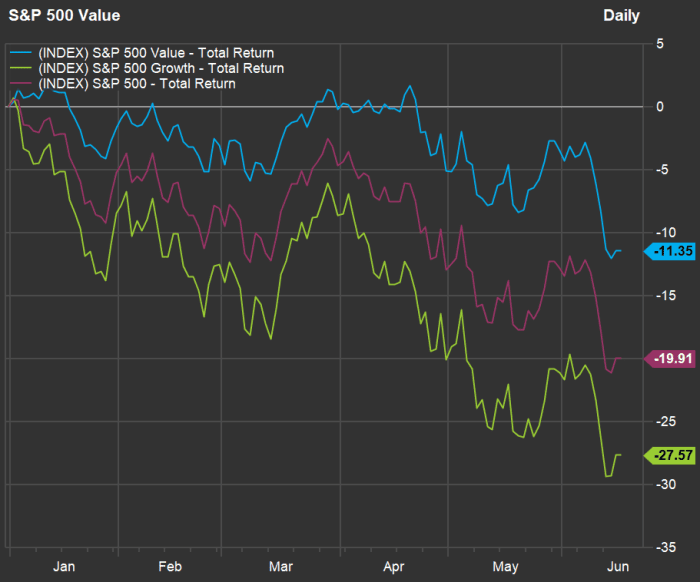Four value-stock picks from a fund manager who steers clear of the energy sector
Jensen Investment Management follows a simple rule for initial screenings of stocks: Companies need to have achieved returns on equity (ROE) of at least 15% annually, for at least 10 consecutive years.
That’s a tall order, and it may provide comfort to investors during a period of market turmoil. The easier growth-oriented strategies of the bull market, driven in part by soaring stocks of companies that hadn’t achieved profitability, are no longer working.
Jensen’s main investment vehicle is the $9.1 billion Jensen Quality Growth Fund JENIX,
During an interview, Tyra Pratt, a co-manager of the Jensen Quality Value Fund JNVIX,
Rob McIver, a managing director at Jensen who co-manages the Quality Growth Fund, was also on the call, explaining why the firm doesn’t invest in the energy sector.
That may seem to place the firm in a difficult position — after all, the S&P 500 energy sector has returned 50% this year. Then again, if we look back 10 years, the sector’s total return has been only 76%, compared with 243% for the full S&P 500 SPX,
The reason Jensen avoids the energy sector is simple: Most companies in the sector cannot pass initial muster by consistently achieving ROE of 15%. During a year in which the price of West Texas crude oil CL.1,
If a company meets Jensen’s initial screen, with minimum 15% ROE for 10 straight years, the firm’s portfolio managers will then subject it to a rigorous qualitative review. McIver said that a few years ago, when an energy company passed the initial screen, “what we were not comfortable with was the company produced a product they didn’t price themselves.”
The soaring profits for energy companies now follow “a long period of shareholder value destruction,” McIver said. “The forces of supply and demand outweigh the pricing opportunity for these businesses. The pricing is commoditized.”
Avoiding the energy sector now has curbed the performance of both funds this year, which Pratt called “a short-term hiccup” within a long-term investment strategy.
Time for value
Let’s begin with a Twitter posting from Jeff Weniger, head of equity strategy at Wisdom Tree Investments:
We might be at an early stage of a value cycle — marked by outperformance of companies that tend to trade lower to earnings and sales than growth stocks do. Value companies also tend to have more stable profits, which fits in well with Jensen’s initial screening methodology.
Here’s a simpler chart showing how the S&P 500 Value Index has outperformed the S&P 500 Growth Index and the full benchmark index so far this year:

It remains to be seen whether the Federal Reserve’s efforts to lower inflation will result in a recession, but the reversal of pandemic-era central bank and fiscal stimulus has had quite an effect on stocks during 2022, making value strategies shine after years of underperformance during the bull market.
Four value stock selections
Pratt explained that the Jensen Quality Value Fund is mostly concentrated in mid-cap stocks, while the firm’s Quality Growth Fund is mainly in large-caps. The fund typically holds shares of 30 to 50 companies.

Tyra Pratt, portfolio manager at Jensen Investment Management.
Jensen Investment Management
She named four examples of stocks held by the fund — one health-care name and three in the consumer discretionary sector. So far in 2022, the health-care sector of the S&P 500 has fared relatively well, with a 13% decline, while the consumer discretionary sector has dropped 31%.
She described the consumer discretionary rout as “an opportunity” for Jensen to increase its holdings of “more durable” companies that have competitive advantages.
Here are the four stocks Pratt discussed:
| Company | Ticker | Average ROE – 10 fiscal years | Total return – 2022 through June 15 | Change in rolling 12-month EPS estimate since Dec. 31 |
| Encompass Health Corp. | EHC, |
31.11% | -13.7% | -4% |
| Pool Corp. | POOL, |
64.36% | -37.2% | 17% |
| Tractor Supply Co. | TSCO, |
34.13% | -17.0% | 13% |
| Carter’s Inc. | CRI, |
26.78% | -27.9% | 15% |
| Data source: FactSet | ||||
The table includes increases in rolling 12-month earnings-per-share estimates, which can be of interest because they can help drive share prices higher over time. They obviously haven’t done so this year, and Jensen follows a very long-term strategy. So far this year, the weighed aggregate rolling 12-month consensus EPS estimates for both sectors have declined 1%.
Here are comments from Pratt about the four companies:
- Encompass Health Corp. EHC,
+3.98% provides inpatient rehabilitation services, which Pratt described as an industry with high barriers to entry. She said the company’s leading market share is enhanced by its technology, which helps it coordinate with hospitals that send patients to its facilities. The company has a “favorable long-term outlook” because of the aging of the baby boomer population, she added. - Pool Corp. POOL,
+1.07% was an obvious favorite among investors during the early phase of the pandemic, as people focused on improving their homes. But investors have shied away this year as the economy has reopened. The company is the largest distributor of pool supplies through small businesses in the U.S. Pratt said the company has a pricing advantage because the pool construction and maintenance businesses they sell to have the convenience of working with only one supplier. As anyone with a pool can tell you, maintenance is hardly “discretionary,” even though the company is in an S&P sector with that name. - Next is Tractor Supply Co. TSCO,
-1.00% , which provides farming supplies and tools for do-it-yourself consumers and focuses on markets “typically overlooked” by Home Depot Inc. HD,-0.03% and Lowe’s Cos. LOW,+1.40% , Pratt said. She cited the company’s “unique product mix,” which is about half edibles/consumables, including livestock feed and agricultural supplies. - Last is Carter’s Inc. CRI,
+2.40% , which is a retailer of clothing for children with its own well-known brands, including OshKosh. Pratt sees Carter’s as a long-term defensive play, in part because apparel for babies and children is less cyclical as clothing needs to be replaced rapidly. “There is also a fashion element” because of Carter’s brands, she said.
Don’t miss: Here’s a winning investment strategy for a long period of commodity shortages




